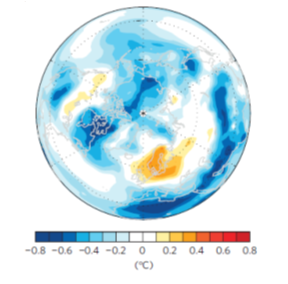Chinese and Norwegian Scientists Investigate the Atlantic Multidecadal Oscillation and Its Climate Impacts by Using CMIP5 models
Date:2016-09-27
The Atlantic Multidecadal Oscillation (AMO)—the leading pattern of SSTs in the North Atlantic region—has attracted considerable attention due to its substantial climate impact. The AMO is considered to be an internal climate variability mode related to the Atlantic Meridional Overturning Circulation. Meanwhile, many model studies indicate that the AMO and its climate impacts are also influenced by external forcing, such as solar variability and volcanic and anthropogenic aerosols. It should be noted, however, that many such studies depended on either relatively short observational records, historical experiments with climate models, or models forced by observed or derived AMO SST/flux anomalies. Hence, it is very hard to disentangle the climatic effects of the AMO from internal variations in the climate system.

Composite mean surface air temperature following avolcanic eruption (Otter? et al., 2010)
In a study recently accepted by Advances in Atmospheric Sciences (Han et al., 2016), scientists from the Institute of Atmospheric Physics and University of Bergen investigated the spatiotemporal characteristics and climatic impacts of the AMO as a mode of internal variability, by comparing the “Pre-industrial Control” output of models participating in CMIP5 with observations. It was found that a positive AMO favors warmer surface temperature around the North Atlantic, and the Atlantic ITCZ shifts northward, leading to more rainfall in the Sahel and less rainfall in Brazil. Furthermore, the results confirmed the existence of a teleconnection between the AMO and East Asian surface temperature, as well as the late withdrawal of the Indian summer monsoon, during positive AMO phases. These connections could be mainly caused by internal climate variability.
The study provides some new clues for decadal prediction in regions mainly influenced by internal climate variability, on the basis of the view that the real climate consists of natural internal variability and external forcing.
References
Han, Z., F. F. Luo, S. L. Li, Y. Q. Gao, T. Furevik, and L. Svendsen, 2016: Simulation by CMIP5 models of the Atlantic Multidecadal Oscillation and its climate impacts. Adv. Atmos. Sci., doi: 10.1007/s00376-016-5270-4. (in press http://159.226.119.58/aas/EN/10.1007/s00376-016-5270-4 )
Otter?, O. H., M. Bentsen, H. Drange, and L. L. Suo, 2010:External forcing as a metronome for Atlantic multidecadal variability. Nature Geoscience, 3, 688–694.
Contact: Feifei Luo, luofeifei212@mail.iap.ac.cn
